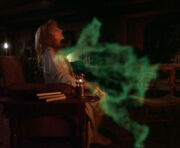No edit summary |
m (Robot: Automated text replacement (-==Background== +== Background information ==)) Tag: apiedit |
||
| (13 intermediate revisions by 9 users not shown) | |||
| Line 1: | Line 1: | ||
| − | [[ |
+ | [[File:Ronin.jpg|thumb|A anaphasic lifeform in Human form.]] |
| − | An '''anaphasic lifeform''' is a [[sentient]] entity made up of [[ |
+ | An '''anaphasic lifeform''' is a [[sentient]] entity made up of [[anaphasic energy]], which differentiates such entities from [[solid]] [[matter]]-based [[symbiotic lifeform]]s. |
Being extremely unstable, such [[lifeform]]s require some sort of conduit to maintain [[molecule|molecular]] cohesion and a [[corporeal]] host with compatible [[biochemistry]] in order to take physical form. |
Being extremely unstable, such [[lifeform]]s require some sort of conduit to maintain [[molecule|molecular]] cohesion and a [[corporeal]] host with compatible [[biochemistry]] in order to take physical form. |
||
| − | They can also travel along a standard [[power transfer beam]], and leave traces of anaphasic [[radiation]] in their wake. When bonded to a [[Human]], the host's |
+ | They can also travel along a standard [[power transfer beam]], and leave traces of anaphasic [[radiation]] in their wake. When bonded to a [[Human]], the host's appearance may change, such as a change in the eye color. |
[[Ronin]] was an anaphasic lifeform. ({{TNG|Sub Rosa}}) |
[[Ronin]] was an anaphasic lifeform. ({{TNG|Sub Rosa}}) |
||
| + | == Background information == |
||
| − | {{Anaphasic may also refer to being subspatial, as in the old hypergeometry terms for the up/down along a 4th orthogonal axis being ana and katta.}} |
||
| + | [[File:Anaphasic lifeform.jpg|thumb|Non-corporeal anaphasic lifeform entering [[Beverly Crusher]]'s body.]] |
||
| + | The anaphasic lifeform, in its non-corporeal form, was a [[CGI|computer generated effect (CGI)]], using for the first time in televised ''Star Trek'' the {{w|LightWave 3D}} software (at the time still the software component of the Amiga Video Toaster Suite package, and later on the software package of choice for the ''Star Trek'' television franchise), provided by [[Digital Magic]]'s [[Joe Conti]] and [[Tim McHugh]]. It was a conscious effort to gain more creative control in contrast to the traditional usage of liquid nitrogen against black velvet, called by Visual Effects Supervisor [[David Stipes]], "an act of God", due to the fact that once employed, getting a good usable shot, using this method, was very much a "luck of the draw" process.(''[[Star Trek: The Next Generation Companion]]'', p. 281) Digital Magic continued to experiment with LightWave 3D software in the remainder of the series, creating amongst others the plasma stream in the later episode {{e|Eye of the Beholder}}. |
||
| + | [[de:Anaphasische Lebensform]] |
||
[[Category:Unnamed species]] |
[[Category:Unnamed species]] |
||
Revision as of 12:18, 24 October 2015

A anaphasic lifeform in Human form.
An anaphasic lifeform is a sentient entity made up of anaphasic energy, which differentiates such entities from solid matter-based symbiotic lifeforms.
Being extremely unstable, such lifeforms require some sort of conduit to maintain molecular cohesion and a corporeal host with compatible biochemistry in order to take physical form.
They can also travel along a standard power transfer beam, and leave traces of anaphasic radiation in their wake. When bonded to a Human, the host's appearance may change, such as a change in the eye color.
Ronin was an anaphasic lifeform. (TNG: "Sub Rosa")
Background information

Non-corporeal anaphasic lifeform entering Beverly Crusher's body.
The anaphasic lifeform, in its non-corporeal form, was a computer generated effect (CGI), using for the first time in televised Star Trek the LightWave 3D software (at the time still the software component of the Amiga Video Toaster Suite package, and later on the software package of choice for the Star Trek television franchise), provided by Digital Magic's Joe Conti and Tim McHugh. It was a conscious effort to gain more creative control in contrast to the traditional usage of liquid nitrogen against black velvet, called by Visual Effects Supervisor David Stipes, "an act of God", due to the fact that once employed, getting a good usable shot, using this method, was very much a "luck of the draw" process.(Star Trek: The Next Generation Companion, p. 281) Digital Magic continued to experiment with LightWave 3D software in the remainder of the series, creating amongst others the plasma stream in the later episode "Eye of the Beholder".
